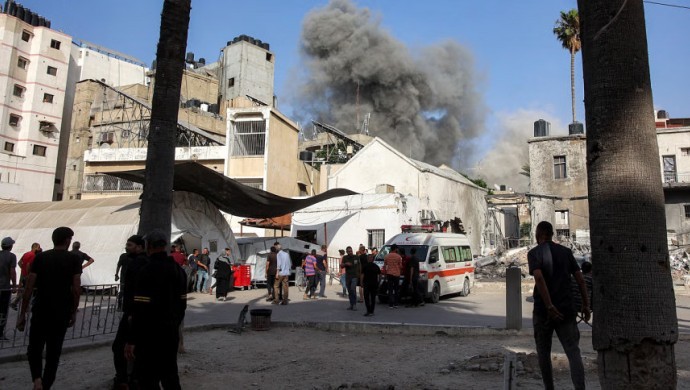The Russian invasion of Ukraine continues to come to the fore as the war intensifies. Western countries have added new sanctions on Russia, including the US ban on Russian oil and energy imports. It is not yet clear to what extent the war will affect the global economy, and it is difficult to foresee how the crisis on the ground will develop in the coming phases. While it is almost impossible to predict how the Russia-Ukraine crisis will develop in the coming weeks and months, it seems that the war will continue for a while.
The increase in food, energy and basic services prices, along with the moderate increase in core goods prices, are also the driving forces of global inflation. All eyes were on energy prices, as the war in Ukraine rapidly increased oil prices. Of course, the problem is not only on the side of energy and raw materials. Consumers don't just feel pain at the pump. Global economies suffer from a general-based increase in food prices, down to housing prices. We expect energy prices to continue to rise in this process, in line with the war phenomenon and the effort to isolate Russian oil, and we believe that the peak of inflation largely depends on the course of oil. Higher inflation will erode growth in real income, possibly resulting in slower growth in real consumer spending.

Comparison of major commodity prices... Brent oil, TTF natural gas, wheat, nickel, gold... Source: Bloomberg
While many Western governments have not completely banned the import of Russian oil, with the exception of the United States, many Western oil companies have essentially implemented self-imposed boycotts of Russian oil. Even if the war ends in the near term, some third countries can be expected to refrain from purchasing Russian oil in the foreseeable future, even without sanctions. As a result, we expect oil prices to remain high in the coming quarters as a major oil producer like Russia is effectively removed from the markets.
The arrival of the Swift ban in Russia brought the sale of global banking stocks. Since the restrictions in the Russian market will affect the input supply especially in Europe due to commodity trade, an industry slowdown can be expected from the 2Q22 period. It is also necessary to take into account that supply chain disruptions will not be fully resolved until later this year.
Globally, there are upward pressures on inflation. It looks like this situation will continue for at least a while. Countries that depend on imports for energy may be more vulnerable. For this reason, countries such as Turkey, which are more sensitive to energy prices, have increased risk-undertaking. The interest position, which is about 40 points below inflation, reduces the coefficient of resistance to a financial turbulence and demand for local assets.
It is difficult to predict clearly how supply and demand will be affected in macroeconomic uncertainties. In this challenging profile, assuming that the US economy is strong enough, the Fed's consideration of raising interest rates nevertheless causes difficulties in maintaining the economic risk adaptation balance for emerging markets. In addition to the current return position, countries that may be more exposed to Russia risk geographically and within the scope of trade relations and that may not have sufficient positive impact on foreign financing net inflows in terms of import bills will be more cautious.
Central Banks Perspective
The Russian invasion of Ukraine has caused oil prices to soar in recent weeks. As a result, this year's CPI inflation forecasts have risen even higher. Despite the uncertainties created by the war, the FOMC is expected to still increase its target range for the federal funds rate this year. We believe that the uncertainties surrounding the economic outlook will lead many FOMC members to believe that an overly aggressive pace of monetary tightening is unreasonable and the need to move in the traditional band. The balance sheet reduction will act as an additional form of monetary tightening, and we expect the first round of it to begin in the summer as planned, while the second round of reduction craters will be planned according to the state of the Russian war.

Comparison of US producer price index and core PCE inflation… Source: Bloomberg
In its March monetary policy announcement, the European Central Bank pointed to an accelerated rate of contraction under the Asset Purchase Program (APP), despite the uncertainty surrounding the Ukraine conflict. The central bank has lifted its commitment to keep policy rates at current or lower levels. The ECB has also made some important changes in its economic projections. The central bank raised its 2022 CPI inflation forecast (from 3.2% previously) to 5.1% and raised its core CPI forecast for this year to 2.6%. While inflation is expected to decline in 2023 and 2024, these forecasts have also risen and the CPI is expected to fall to 2% over time. Lagarde said the Ukraine conflict poses a significant upside risk to the inflation outlook. Meanwhile, the ECB's GDP growth projection for 2022 has been lowered to 3.7% from the previous 4.2%, with little change in the growth outlook for 2023 and 2024. The outlines of the ECB's monetary policy approach, in our view, leave the Central bank on track to raise the first 25 basis point deposit rate at its December 2022 monetary policy meeting.
Turkish Domestic Market Perspective
On the growth side, foreign demand continues to be supportive. On the other hand, the energy supply problem, which has recently emerged due to geopolitical risks, has an important place in terms of industrial activity in the Euro Area. In the current axis, we will observe the effects of the problems originating from Russia on the country's energy supply and the direct electricity demand of the industrial sector. We will discuss factors such as the developments in the exchange rate in 2022, the economic slowdown caused by the global supply shortage, the problems that the Omicron variant may create especially for our export partners. We expect that practices such as facilitating credit conditions and a broad fiscal policy ground will continue in the implementation of growth-oriented policies.

Emerging market currencies, comparative performance analysis since the beginning of the year… (Normalized by factor 100) Source: Bloomberg
We still care about the investment effect in terms of sustainable growth effect. Therefore, the macro environment needs to remain stable and predictable in firms' production capacity and employment trends. Developments and possible changes in credit policies are issues that we need to follow closely in the near future. If you turn to a policy of supporting economic growth with low interest rates and high credit growth, you run the risk of experiencing a period of heightened vulnerabilities. From a growth perspective, we see problems such as the effects of the last war conditions, domestic and foreign demand, and the decrease in the contribution of input and energy problems to production as negative. Although we expect the growth to normalize towards the 4% band this year, we evaluate the current risk balance to the downside.
Annual inflation in Turkey rose to 54.4% in February 2022. Considering that there are nurturing factors other than the exchange rate in the high inflation process, we will experience this effect for a while. Moreover, if the expectation of a depreciation in TL comes to the fore due to the Fed's rate hikes, the exchange rate effect may push inflation up again. There are many cost factors that affect inflation. We monitor many risk factors such as commodity prices, demand conditions, wages, managed prices, inflationary dynamics created by agricultural production in food. We expect the rise in inflation to continue until the summer months of the year and to decline slightly in the last month of the year due to the significant base effect after maintaining its high course for a while. At the beginning of 2023, the base effect in January, February and March of this year will help bring down the annual inflation rates.
The recent turn of the sanctions against Russia into a showdown may cause much higher levels to be seen in commodity prices. Russia is the leading country in natural gas and oil imports. In addition, Russia ranks third in the world in wheat production from agricultural products. Inflation is quite high and the PPI, which is close to 100%, causes the cost burden here to be still very high. In an environment where consumer inflation is in a very high band above 50%, food and energy-based inflation stand out as the items that increase the risk of deviation the most.
We observe the effects of the increase in construction costs together with the factors arising from exchange rate and inflation on the acceleration of the increase in housing prices. The demand environment in the shrinking housing stock also increases the price volatility in the housing market. While changes in housing supply and demand, especially after the Covid-19 pandemic, affect prices through financing costs and household demand; In the next phase, current prices rose significantly in many regions with exchange rate volatility. The constraints in the housing supply and at this point, housing prices and rents that exceed their purchasing power due to inflation are at the center of this.
The main moves in the fight against inflation are concentrated on the side of fiscal policy, and in this process, measures such as tax reductions, subsidies and other incentives and currency-protected lira deposits come to the fore. Our estimation is that annual inflation will continue to rise above the 50% band until the summer months, as predicted by the CBRT, remain at high levels for most of the year, and decline after November, especially in December, due to a very serious decline.

Current account balance... Source: CBRT
In the current account balance, we will see the results of the applications in the field of the new economy perspective, which the economy administration has implemented to increase exports. In this context, we would like you to know that we draw attention to negative risks such as risks related to the external demand outlook in exports and increased energy bills in imports. The improvement in the 2021 profile stemmed from the reduction of the effects of the epidemic and the strong outlook in exports and tourism. In imports, the slowdown in consumption-based imports and the neutralization of gold imports last year eased the pressure. However, the increase in energy costs on the import side neutralized this positive effect.
In the current account balance, we closed the year 2021 with a total current account deficit of 14.88 billion dollars. This corresponds to about 2% of GDP. According to the market's current account projections, our expectations for 2022 and beyond are more moderate. The main reason for this is; Energy costs are likely to remain high as a result of the effects of the sharp depreciation of the lira. If we include the conditions of the last war, especially due to the increase in energy imports, we expect the current account deficit to show a trend towards 2020 levels this year.
While rising inflation and a significant decline in purchasing power reduce both predictability and confidence in the economy, the dollarization rate has been rising over the years. Financial dollarization, which was at the level of 55% at the beginning of 2021, entered the band of 60-65%, and after the exchange-protected TRY deposit product that guarantees possible losses from the exchange rate, as of December 20, 2021, it has now fallen below the 60% band with the transformation of real and legal persons. By contrast, total bank deposits are still advancing at a historically high half dollarization rate. While the increase in dollarization continues, the difficulties we experience in attracting foreign capital have caused significant depreciation in TRY over the years.
Monetary and Fiscal Policy
The Central Bank interrupted this cycle as of January, after making a 500 basis point policy easing with successive rate cuts. As a result; With an open-ended reference to an approach emphasizing the value of the TRY, the Central Bank suspended the rate cuts and said that the "liraization strategy" is one of the main elements of the policy review process. According to this; With collateral diversification and liquidity management practices, new financial products will be created with a holistic approach that focuses on the use of Turkish Lira in the system. From this, it is understood that the Central Bank wants to create a strategy that focuses on liquidity instruments and currency protected deposit products for lira price stability, and will pay attention to financial products and liquidity factors rather than the possibility of rate hikes. While interest rates, which were continuously and rapidly lowered until the end of 2021, were the main source of a rare depreciation in the lira until the end of December, the government implemented emergency lira measures at the currency-protected product center and we watched the exchange rate settle.

Turkey CPI, policy rate, TRY and oil price comparison… Source: Bloomberg, TURKSTAT, CBRT
In the first effects after December 20, the exchange rate made a sharp correction and it is important that the weight of the transition from foreign currency to TRY has increased in the continuity of this movement. In an environment where the Fed will rapidly increase interest rates, we see high inflation and extremely negative lira real yields as sources of concern. It is aimed to use more lira in the money circulation in the financial system and economy and thus to create a price stability phenomenon independent of interest. The withdrawal of foreign currency accounts, which started with real persons as of the beginning of the year, continues with the withdrawals made from legal entities. In the upcoming period, we will follow the developments in the FX-protected deposit product in terms of the dollarization process. Depending on the negative news flows and the negative real return effect created by inflation, the movements and preferences in the accounts will be important.
Credit pricing will be high in 2022 due to the high risk environment, asset-liability management of private banks and inflation. Therefore, it is possible for bank rates to remain at or above current levels in their normal course. On the public side, we can expect credit outflows to be higher than the private sector, with the effect of government-sourced credit incentives and CGF. The 14% central bank funding causes a significant margin gap here.
In the new economy perspective, we see that the Central Bank focuses on economic management targets rather than inflation priority. At this point, fiscal policy has been given a greater role in reducing inflation to the level of developed countries in the medium term without using monetary policy. In this process, we see that the FX-protected deposit account will be at the center of mitigating the economic shocks caused by the exchange rates. However, as inflation rises or slows its decline, it will become more difficult to maintain this practice. There is a possibility that negative real interest rates will stimulate foreign exchange demand, low interest rates will heat inflation compared to general demand, and this will affect exchange rate movements and price expectations.

Kaynak Tera Yatırım
Hibya Haber Ajansı







